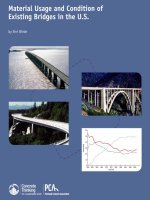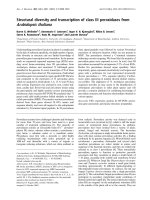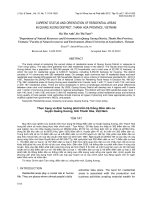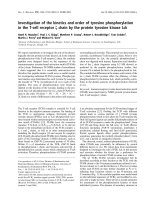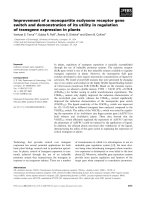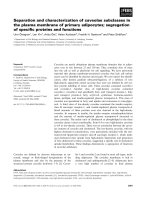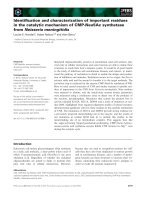Species diversity and usage of medicinal plants in dong tau village hoa binh province
Bạn đang xem bản rút gọn của tài liệu. Xem và tải ngay bản đầy đủ của tài liệu tại đây (480.45 KB, 37 trang )
TABLE OF CONTENTS
LIST OF ACRONYMS
LIST OF TABLES
LIST OF FIGURES
ACKNOWLEDGEMENT
I. INTRODUCTION ................................................................................................................... 1
II. OBJECTIVES, CONTENTS, LIMITATIONS, METHODOLOGY .................................... 3
2.1 Objectives and scope ............................................................................................................ 3
2.1.1 Objectives .......................................................................................................................... 3
2.2 Research Methodology ......................................................................................................... 3
2.2.1 Desk research ..................................................................................................................... 3
2.2.2 Field Survey Methodology ................................................................................................ 3
2.2.3. Method of consulting experts ........................................................................................... 7
III. NATURAL – SOCIAL – ECONOMIC CONDITIONS ...................................................... 9
3.1 Geographical location ........................................................................................................... 9
3.2 Topography......................................................................................................................... 10
3.2.1 The topography of low hills ............................................................................................ 10
3.2.2 Low topography............................................................................................................... 10
3.3 Weather and climate ........................................................................................................... 10
3.4 Resources ............................................................................................................................ 11
3.4.1 Population and Labor....................................................................................................... 11
3.4.2 Land Resources ............................................................................................................... 11
3.4.3 Water Resources .............................................................................................................. 11
3.4.4 Forest Resources .............................................................................................................. 11
3.4.5 Mineral Resources ........................................................................................................... 12
3.5 Evaluation of local potential ............................................................................................... 12
3.5.1 Advantages ...................................................................................................................... 12
3.5.2 Disadvantages .................................................................................................................. 13
IV. RESULTS AND DISCUSSION ........................................................................................ 14
4.1 Assessment of the diversity of medicinal plants ................................................................ 14
4.1.1 Diversify of species sector ............................................................................................... 14
4.1.2 Diversity of plants .......................................................................................................... 15
4.1.3 Diversity of life forms of plants ...................................................................................... 16
4.2.1 Status of cultivation of medicinal plants in local communities ....................................... 17
4.2.2 Form gathers medicinal plants ......................................................................................... 20
4.2.3 Forms of use and preservation of medicinal plants raw material locally ........................ 22
4.3 The best remedies is simple and has high applicability in local ......................................... 23
4.3.1 Group gastrointestinal disease ......................................................................................... 23
4.3.2 Group of bone and joint disease ...................................................................................... 24
4.3.3 Group skin diseases ......................................................................................................... 24
4.3.4 Diseases of endocrine disorders ...................................................................................... 25
4.3.5 Eye disease ...................................................................................................................... 25
4.4 Analysis of the development of medicinal plants in local communities ............................ 25
4.4.1 The favorable factors for the development of natural resources of medicinal plants in
local .......................................................................................................................................... 25
4.4.2 Difficult in the development of medicinal plants ............................................................ 26
4.4.3 Opportunities for development of medicinal plants ........................................................ 26
4.4.4 Challenges in sustainable development of medicinal plants ........................................... 27
4.5 Proposed solutions for sustainable development of medicinal plants locally .................... 27
4.5.1 Planning ........................................................................................................................... 27
4.5.2 Policies ............................................................................................................................ 28
4.5.3 Techniques ....................................................................................................................... 28
V. CONCLUSION, LIMITATIONS, RECOMMENDATIONS ............................................. 29
REFERENCE
APPENDIX
LIST OF ACRONYMS
Notation
Meaning
PRA
Rapid Assessment of rural people's participation
RRA
Rapid Rural Assessment
SWOT
Strengths, weaknesses, opportunities and threats
LIST OF TABLES
Table
Name
Page
The number of families, general and species of plants are used as
4.1
14
medicines in Dong Tau village
4.2
10 families was medicinal plants widely used in Dong Tau village
15
4.3
Life-forms of medicinal plant species in the study area
16
4.4
Situation of drug use by people in Dong Tau village
17
4.5
Total use of medicinal plants according to parts of trees
21
4.6
Forms of medicinal plants used in Dong Tau village
22
LIST OF FIGURES
Figure
Name
Page
Location of study site: (a) Viet Nam, (b) Hoa Binh province, (c)
3.1
9
Luong Son district, (d) Hoa Son commune
4.2
Cultivation status of medicinal plants in Dong Tau village
18
4.3
Alpinia chinensis (Alpinia chinensis (Retz.) Roscoe)
19
4.4
The Citronella (Cymbopogon Nardus Rendl)
19
4.5
The herb is dried and then wrapped in plastic bags
23
ACKNOWLEDGEMENT
With the permission of the Vietnam Forestry University, Faculty of Forest Resources
and Environment Management, I have completed the thesis: "Species diversity and usage of
medicinal plants in Dong Tau village, Hoa Binh province.”
To perform this topic, I have received the enthusiastic support of teachers from
Vietnam Forestry University, the Institute for Forest Ecology and Environment, local officials
and the rangers of Dong Tau village, Hoa Binh province.
After completion of thesis, I would like to deeply thank supervisor Dr Le Xuan
Truong who has guided and helped me in the process of research topic locally.
Because of my private limitations in term of expertise knowledge, surely, there are
some certain shortcomings and inadequacies in my thesis. Therefore, I truthfully expect to
receive active and frank responses from lectures as well as contributing opinions from friends
so that I can promote my research later.
I sincerely thank you!
Hanoi, 19 October, 2014
Student
I. INTRODUCTION
Vietnam is a rich tropical country at plant genetic resources, with more than 3948
plant species classified as medicinal plants. It contributed the biodiversity of Viet Nam.
Biodiversity is very important for our life. Since ancient times, people have used this resource
for many different purposes such as food, vegetables, and medicines... Throughout its history,
Vietnamese traditional healers have used medicinal plants to prevent and cure certain types of
diseases through indigenous medical procedures. Viet Nam with 54 different ethnics, each
ethnic has knowledge about their own traditional medicine, in which the Muong ethnic in Hoa
Binh is no exception. Along with the unique culture, traditional medicine of Muong ethnic
imbued with local knowledge, make a special appealing to those who like to explore and
discover life. The current income of Muong Community in Hoa Binh is mainly from herbal
medicine drug. However, the documentation of medicinal plants, remedies are also very rare.
Hoa Binh Mountain owns more than 300 species of medicinal herbs, including many precious
and endemic species. This is an advantage of local development and it has the potential to
expand production and service as tourism to visit the medicinal village, built resort and
healing.... However, numerous species of medicinal herbs in Hoa Binh are eradicated and it is
at risk of extinction. The main reason is that people's lives are poor and people who go
harvesting, exploiting the pharmaceuticals lack of understanding, lack of awareness about
preservation and conservation of medicinal plants, No method of organization and
management to produce in a scientific way.
In Dong Tau village, Hoa Son commune, Luong Son district, Hoa Binh province is
considered a favorable condition for plant growth and development. Medicinal plant resources
are abundant and diverse, local people use medicinal plants to cure very much. Realizing the
investigation, research on the medicinal plants used in this work is necessary, in addition to
contributing to a clear assessment of the current state, the local potential to enhance the
conservation and development of medicinal plants, provide timely data and information on
1
medicinal plants to cater to people's lives contributing to keeping the experience drug use
precious indigenous people.
So, I have implement thesis: "Species diversity and usage of medicinal plants in
Dong Tau village, Hoa Binh province.”
2
II. OBJECTIVES, CONTENTS, LIMITATIONS, METHODOLOGY
2.1 Objectives and scope
2.1.1 Objectives
- To assess the diversity of medicinal plants used by local people and experience in the use
and cultivation;
- To determine the challenges of medicinal plants as the basis from which the proposed
solution development resources at the local medicinal plants.
2.1.2 Scope of the study
- Time: From 06/2014 to 08/2014.
- Location of study: administration Range Dong Tau village, Hoa Son commune, Luong Son
district, Hoa Binh province.
2.2 Research Methodology
2.2.1 Desk research
- The materials on natural conditions, climate, hydrology, soil, topography, natural resources.
- The information and data on economic conditions, social conditions: population, labor,
ethnic composition, cultivation practices.
- Use the reports and documents involved.
2.2.2 Field Survey Methodology
During the investigation we used tools such as PRA supported primarily (Rapid
Assessment of rural people's participation) and RRA (Rapid Rural Assessment) to collect
information and field data. Specifically, we directly went to the field:
- Interviews with the management of the communes and villages;
- Interviews with clinic staff;
- Interviews with families, especially those who understand medicine as his sweet mother;
3
2.2.2.1 Methods of sample collection and handling of specimens
After sampling the specimens in the field will be processed and made into specimens
under common method currently in Vietnam Forestry University.
2.2.2.2 Methods of People's interviews and group discussions
With interview survey method we mainly use the tables to interview local people who
are knowledgeable about drugs in the community to statistical components of medicinal
plants, utility, used parts, current state of cultivation, the use of medicinal plants experience of
local communities. The survey results are listed in table investigation "Dashboard synthetic
composition of species, uses".
4
STATISTICAL TABLES OF THE SPECIES, THE USAGE
Investigator: ……………........
Date: .......................................
Location: ..................................
Name of Life
Number
Cultivation
Use
species
form
Function
reality
1
2
….
The investigated
..........................
With the typical remedy of diseases in groups of people and how to use (component,
content, cooking, abstinence ...) I recorded in questionnaires.
5
MEDICINAL PLANTS TABLE BY DISEASE
Investigator: ……………....
Date: ……………………
Location: ………......…...
Number
Disease
1
Digest
2
Osteoarthritis
3
Inflammatory
4
Disease of women
Name
Function
How to use
Note
Fever, colds
5
appearance
6
Insect bites
7
Respiratory disease
Diseases of the
8
nervous system
9
Sick children
10
Urinary disorders
11
Poisoning
12
Parasites
Investigator
……….………..
6
In addition, I took some photos of medicinal plants, stones, natural environment
habitats and took some of the productive activities of local communities associated with
medicinal plants.
When conducting discussions with people, I used PRA tools to find out which factors
affect the medicinal plant resources locally. Then diagram SWOT analysis to assess the
advantages, disadvantages, opportunities and challenges for sustainable development issues of
medicinal plants locally.
Finally, based on the results of the study subjects, combined with medial consultation
to propose solutions for sustainable development of medicinal plants. These solutions are
consistent with the local people through group discussions and exchanges, accumulate
experiences of the community.
2.2.3. Method of consulting experts
2.2.3.1 Methods of evaluation specimens
On the basis of specimens collected and share photos, field notes, name unknown
species is determined by plant experts with experience of Forestry University, through
comparison with specimens’ Preliminary version available to determine the species name.
Then we conducted a search, reference to the description in the monograph of the plant to the
species name. The materials used include: "Trees Vietnam" Volume I, II, III by Pham Hoang
Ho; "Trees are useful in Vietnam" by Tran Vo Van Chi and Co; "Dictionary of medicinal
plants in Vietnam" by Vo Van Chi; "Medicinal plants and herbs Medicine" Lan Hoang Van
Vinh Hy; "Medicinal plants and herbs Vietnam" Do Tat Loi; Ministry of plants Vietnam (for
them Annonaceae, Myrsinaceae, Orchidaceae (Dendrobium varies), Lamiaceae, Verbenaceae,
Asteraceae, Liliales, Polygonaceae, Apocynaceae); "NTFP Vietnam"; "Handbook lookup and
identify them angiosperms in Vietnam" Nguyen Tien Ban, etc…
The name of the species, according to the updated list of all plant species in Vietnam,
2007 (Agriculture Publishing House).
7
2.2.3.2 Method of making lists of medicinal plants
Based on the list of plant names and their effects, I established list of medicine.
Species of plant are classified according to their order and family; the species are arranged in
alphabetical order.
THE LIST OF PLANT INVESTIGATION BY TAXON LEVEL
Number
Name
Vietnamese
name
Endanger
Latin
Form
Use
Cultivation
How
reality
to use
Function
name
I. Division
1. Class
1.1.1 Family
1
Species
…
…
….
…
…
…
…
…
…
From the complete list, summing the number of families, genera and species for each
branch, prorated % of the families, genera and species in each sector compared to the entire
system as a basis for analysis, assessment of multiple form at the level of the lower branches
and branches.
Factors life forms, uses, parts used, the current state of cultivation, usage, endangered
(species that are not in the Red Book of 2007 or in accordance with Decree 32/2006 / ND-CP
- About Management of flora and fauna endangered, rare, then leave it blank) was added
based on the statistical results above.
2.2.3.3 Method proposed solution
From the study results combined with the actual situation in the local survey, the
opinions of commune officials, experts and local residents, we proposed some measures to
improve the usability of medicinal plants and development of effective and sustainable.
8
III. NATURAL – SOCIAL – ECONOMIC CONDITIONS
3.1 Geographical location
Dong Tau village belongs to Hoa Son commune, located in the northeast of Luong
Son district. In 2010 the land was 2387.0 hectares of nature, including mountainous areas
account for about 47% of the natural area, the population density of 239 persons / km 2. There
are two main ethnic groups in the area are Muong ethnic and Kinh ethnic. Location:
- In the North adjacent to Phu Man, Thach Hoa, Dong Yen - Quoc Oai district
(Hanoi).
- In the South adjacent to Nhuan Trach Luong Son district.
- In the East adjacent to Xuan Mai town- Chuong My district (Hanoi).
- In the West adjacent to Luong Son town- Luong Son district.
Figure 3.1 Location study site: (a) Viet Nam, (b) Hoa Binh province, (c) Luong Son district,
(d) Hoa Son commune
9
3.2 Topography
Hoa Son is a mountainous communes, average altitude is 250 km above the sea level.
3.2.1 The topography of low hills
Area of 1,120 hectares, accounting for 47% of the natural area, concentrated in the
northwest and the northeast part of the commune). On this terrain is mainly regenerated forest
regeneration and afforestation business combination ecological protection forests produce
abundance of plant species in the region. Hilly area northwest is the focus of watershed
provides irrigation, domestic water main in the commune.
3.2.2 Low topography
The remaining area accounted for 53% of the natural distribution concentrated in the
south and southeast of the commune. Elevation is 30-35m popular, somewhere rice
cultivation. The main colors create many agricultural products of high economic value.
3.3 Weather and climate
+ One year have two seasons: the hot season from April to September, the dry season
from October to March next year.
+ Average annual temperature of 23.40 C, the average monthly temperature is highest
28.80 C (July) and the lowest is 16,20C (January).
+ Average annual rainfall is 1,769 mm, but not evenly distributed among the months
of the year. Rain focuses mainly from June to September, especially in November and
December rainfall is low.
+ Prevailing wind direction is northeast monsoon (dry season) and colors Southeast
wind in the hot and humid season.
Overall, Hoa Son commune weather favorable for agricultural production, especially
food, flowers and vegetables. However, the heavy rains of summer color hills prone to
landslides, flooding fields and monsoon damage to agricultural production and affect the
health and life of local people.
10
3.4 Resources
3.4.1 Population and Labor
The population of the commune was 5,619 people (1,394 households), including
Muong and Kinh ethnic groups living together. Distributed population of 11 villages: Co Tho,
Tan Son, Bui Tram, Go Bai, Dong Goi, Hanh Phuc, Suoi Nay, Dong Quyt, Tan Hoa, Dong
Tau, Suoi Vinh.
The commune has a total of 2,717 employees; some workers are classified according
to the following industries:
- Agricultural labor: 1,137 employees, accounting for 41.8%.
- Labor industrial, construction and other industries: 1,143 employees, accounting for
42.1%.
- Labor Services, Commercial: 437 employees accounted for 16.1%.
3.4.2 Land Resources
Group of red gold Feralit land: Occupying 55% of the natural area, distributed over
mountainous terrain. Humus average (M = 1.4 ÷ 1.6%). Phosphorus and potassium are often
poor digestion (6-8 MLG / 100 g soil). Mechanical components are from light to heavy meat.
3.4.3 Water Resources
Surface water is mainly from ponds; respond to the development of agricultural
production.
Hydrographic: In the rainy season, large amounts of water squeeze flow, rainfall
period extending upstream flood-prone fields. Dry season has water streams down, small flow
rate; water flow decreases rapidly, need to build reservoirs and dams to hold water for
agricultural production.
3.4.4 Forest Resources
Hoa Son commune have 460,9ha forest land, accounting for 19.31% of the area is
mainly natural forest production. The entire forest area above has been allocated to the
11
household and organization management; up to now largely taken care of newly planted
forests thrive. The area of forest land is increasing every year has contributed to soil erosion,
soil runoff, landscaping and environmental improvements sustained in the watershed.
3.4.5 Mineral Resources
According to the survey results, a number of businesses inside and outside the
province, the mineral resources in Hoa Son commune are mainly granite with large reserves
are concentrated in the neighborhood of Voi Mountain belongs to Nay River. Now, some
companies are licensed quarries construction materials.
3.5 Evaluation of local potential
3.5.1 Advantages
Hoa Son has a favorable geographic location. There are many agricultural products,
have high economic value such as fresh fruit, seafood, flowers, plants, pork, and poultry.
The system infrastructure of economic, social is invested to build rapidly in both
quantity and quality, to meet the growing demands of economic development, local economic
development creates attractive with investors.
Labors are young. They can acquire and apply the advanced techniques in
manufacturing. The investment capital of the state, businesses, companies, economic
organizations and individuals has increased rapidly in recent years for production and
business, building technical infrastructure, helping to change the face rural areas and create
more jobs with stable incomes for workers
Hoa Son has a strong political system, directing economic development and social
well managed. This is a convenience factor is fundamental in organizing and mobilizing
people to participate in the new rural construction.
12
3.5.2 Disadvantages
In 2011-2015, the agricultural land will decrease rapidly due to the process of
urbanization and infrastructure construction of Hoa Binh province, many households will lose
land.
System infrastructure, socio-economic do not respond of economic development,
culture and society in the period to accelerate the process of industrialization and
modernization of the economy.
There are many projects of building infrastructure of national, provincial, but they did
not officially approved, so difficult to prepare of the project of building a new countryside, as
well as draw up plans to build infrastructure stories of social economy.
13
IV. RESULTS AND DISCUSSION
4.1 Assessment of the diversity of medicinal plants
4.1.1 Diversify of species sector
Through investigation in Dong Tau village, some species are used curing people of
120 species belonging to 2 phyla: Fern (Polypodiophyta) and Magnolia Branch
(Magnoliophyta). The distribution was evident through the following table:
Table 4.1 The number of families, general and species of plants are used as
medicines in Dong Tau village
Branch
Phylum of flora
Number
Species
Rate
Number of
%
species
2
1,92
2
3,45
2
1,67
21
21,19
12
20,69
25
20,83
of
species
Fern ( Polypodiophyta)
Family
Rate %
Number
of species
Rate %
Onion
Magnolia
(Liliopsida)
branch
Magnoliace
(Magnoli
(Magnoliop
80
76,89
44
75,86
93
77,50
103
100
58
100
120
100
ophyta)
sida)
Total
The data in Table 4.1 shows that the number of species distributed unevenly, mainly
Magnolia (Magnoliophyta) with 56 family accounted for 97%, 101 branches accounted for
97.3% and 118 species accounted for 98% of the Fern (Polypodiophyta) accounted for a very
small percentage.
14
4.1.2 Diversity of plants
Total of 120 species of 58 plant families, there are 10 species, they have used the
most; the results are shown in Table 4.2.
Table 4.2 10 families was medicinal plants widely used in Dong Tau village
Branch
Species
Ordinal
Name of family
Number of
number
Number
Rate
of species
%
Rate %
branches
Castor-oil plant
1
8
7,77
12
9,92
(Euphorbiaceae)
2
Daisy (Asteraceae)
8
7,77
11
8,26
3
Coffee (Rubiaceae)
6
5,83
6
4,96
4
Ginger (Zingiberaceae)
4
3,88
6
4,96
5
Bean (Fabaceae)
5
4,85
5
4,13
6
Orange(Rutaceae)
3
2,91
4
3,31
7
Rice (Poaceae)
4
3,88
4
3,31
8
Cotton (Malvaceae)
3
2,91
3
2,48
9
Amaranth (Amaranthaceae)
3
2,91
3
2,48
10
Dayflower (Commelinaceae)
3
2,91
3
2,48
Total of 10 species families
47
46,15
57
46,29
Extant
56
53,85
63
53,71
Total
103
100
120
100
The statistical results showed that most of family have 1-2 species which are used
(48/58 families). The Castor (Euphorbiaceae) are used the most with 12 species, accounting
for 9.92%; The second is the Asteraceae (Asteraceae) has 10 species accounted for 8.26%;
15
the rest have smaller numbers; The total species are used 57, accounting for 46.29% of the
total number of species counted. Thus only 10/58 families have accounted for nearly half of
the species and branches are used, this group have distributed popular in local and
development medicinal plants in community.
4.1.3 Diversity of life forms of plants
Based on the survey data was combined with the scale of plant life forms according to
the document "The trees Vietnam" (2000), we have synthesized and classified into life forms
of plants medicinal plants in Dong Tau village as the following table:
Table 4.3 Life-forms of medicinal plant species in the study area
Ordinal
Number of
Life form
Rate %
number
species
1
Grass
54
45,00
2
Shrubs
23
19,17
3
Herbaceous vines
18
15
4
Small trees
10
8,33
5
Dust crawl
4
3,33
6
The average tree
4
3,33
7
Woody vines
3
2,50
8
Types of bamboo trees
1
0,83
9
Large trees
1
0,83
10
Small trees then either dust
1
0,83
11
Woody vines or creeping dust
1
0,83
120
100
Total
16
The results shows that there are 120 species of plants are used as medicines detected in
the study area, belong to 11 different life forms. In which grasses type have the greatest
number of species, with 54 species accounted for 45%; Shrubs have some form of fewer
species with 23 species accounted for 19.17%, little more herbaceous forms Climbers 18
species accounted for 15%, small tree form with 10 species accounted for 8.33%; the rest are
other life forms negligible proportion.
The Shrubs form have a relatively large proportion (19.17%), but most of them are
wild shrubs or people used to farm for fencing, even though medicinal value but little people
attention, interest use. It also has less impact on the utilization of medicinal plants in their
locality. It can be seen with the ordinary form of the species living mostly grass and shrub
group, this group has a short life cycle, ability to occupy less space. This is convenient for
operators to use and cultivation in the future.
4.2 Status of medicinal plants used by people in Dong Tau village
4.2.1 Status of cultivation of medicinal plants in local communities
In order to improve the accuracy and reliability for topics we've done interviews with
35 households.
Table 4.4 Situation of medicinal plants use by people in Dong Tau village
Number of
Rate%
people
People are interviewed
35
100
People always make up a prescription
3
8,57
People know to use drug in their family
15
43
The interviewees group have 3 people make up a prescription for patient (8.57%), they
used the plants in the garden at home and have 15 people knew Vietnamese traditional
17
medicine at home (43%), so this is an advantage of local which needs to be maintained and
promoted.
After the investigation, interviewing the families, we have identified in Dong Tau
village has 120 species of medicinal plants belong to 58 families. The majority of medicinal
plants are mostly grown naturally with over 49 species accounted for 40.83%, in addition to
28 species of medicinal plants cultivation altogether 23.33% and 43 newly planted trees, just
rising naturally accounts for nearly 35.83%
45
40
35
30
25
20
15
10
5
0
Grow naturally
Grow naturally and planting
Planting
Figure 4.2 Cultivation status of medicinal plants in Dong Tau village
From the table we can see, the medicinal plants are grown to serve the medical needs
less, only half the number of species growing in the wild. However, the species has been
planted has grown naturally relatively high, it may be a promising species, should be
considered for more efficient exploitation of the species. Here are two trees growing
techniques are locals grow the most, we are not only medicinal value but are species of high
economic value to households during the survey:
18
+ Planting techniques The Alpinia chinensis (Alpinia chinensis (Retz.) Roscoe)
Tillage techniques: Alpinia chinensis is tolerant to environmental conditions: drought,
flooding ... adapt in many types of soil, meaning Alpinia chinensis is not picky soil. However,
for high yield, Alpinia chinensis also need good soil humus.
Planting techniques: choosing tall ground, near water tank, pit 30-40cm, compost,
manure is about 1-2kg per 1 hole, backfill and then cut a branch rhizome with put down,
landfill, water. After 4-5 days Alpinia chinensis was restored, with new roots, sprouts popping
up. Sometimes, a little extra watering is a good fertilizer for Alpinia chinensis. 4-5 months
after planting tree root, but when necessary, trim a few branches, bulbs back stabbing another
branch, so harvest year- round.
Figuge 4.3 Alpinia chinensis (Alpinia chinensis (Retz.) Roscoe)
+ Planting techniques The Citronella
Figure 4.4 The Citronella (Cymbopogon nardus Rendl)
Tillage techniques: Citronella is very easy to grow plants, not picky land, adapt to
external conditions well.
19
Planting techniques: Select bare ground, clean grass; dig holes 20 x 20 cm wide, 20
cm deep, each hole from 0.3 to 0.5 kg of compost mixed with topsoil. Take 1- 2 branch cut
lemongrass leaves, dry leaf sheath stripped out, if at the root sheath, long roots are cut. Put the
branch 15 -200 then backfill. Watering to wet the root. On sunny day you can irrigate to help
root grow up quickly. After planting 3-4 months can prune large branches to sell, eat or take
leaves to cook, it is good for hair.
+ Cultivation of other plants
For other species, forms of cultivation are mainly grown with other species in the
garden, or plant themselves and grow in the garden of the family. There are some species can
grow naturally in soil hills, they are very difficult to grow, long harvest period makes it is
difficult to propagated. For example, Jasminum subtriplinerve Blume (tea) live in hilly and
forest edges, Smilax glabra Roxb (Thổ phục linh). Long time to harvest ... This is one of the
factors that make it is difficult to shape and develop the economic value species.
4.2.2 Form gathers medicinal plants
From field surveys we found the experience of exploitation and processing of
medicinal plants of the people. It is very simple but quite effective. Depend on the part of
medicinal plants, remedy that people have a different collection of medicinal plants.
Harvesting techniques:
+ Choose sunny days for ease of drying, and processing.
+ Harvest tubers: When digging avoid drying or broken roots.
+ Harvest the leaves: Cut the leaves as required (the old leaves or buds ....), spread
thin, stacked or not litter because the leaves will be prone
+ Harvesting bark: Use cord to tie the trunk of trees or branches then slitting knife into
pieces, easy drying and curling into liquidation. If the arbitrary removal will affect the growth
of plants and reduce the value of herbs.
Some note when collecting:
Identify proper harvesting period.
+ For root crops: Harvesting begins when the yellow tree leaves, old original, this time
focusing more active in roots.
20
+ For tree leaves: Usually harvested when plants bud.
Use parts of each species are shown in Table 4.6 below.
Table 4.5 Total use of medicinal plants according to parts of trees
Ordinal
numbers
Total use
Parts of trees
(Trees)
Rate %
1
Leaf
91
46,91
2
Trunk
48
24,74
3
Tubers
19
9,79
4
Fruit
11
5,67
5
The whole of trees
7
3,61
6
Flower
7
3,61
7
Tops
4
2,06
8
Roots
4
2,06
9
Seed
2
1,03
10
Bark
1
0,52
194
100
Total use of medicinal plants
According to statistics, the most parts are used the leaves and trunk, with 91 and 48
times are used (46.91% occupancy rate and 24.74%), parts used at least 1 time is bark
accounted for 0.52%. As the results, the plants were collected mainly parts of leaves, fruits, or
trunk, it can effect to the growth and development of trees. However, there are a number of
trees to be harvested in the form of digging roots, cutting tree trunk sections and it can reduce
the number of species in the region. So, when exploiting this form should make a reasonable,
proper technique to just bring therapeutic effects without harming the tree.
To see more clearly the diversity of medicinal parts of the plant, I calculate the
number of parts used in a species (H) by the formula:
H = Total use of parts of the plant /Total of trees =
21
=1.62

